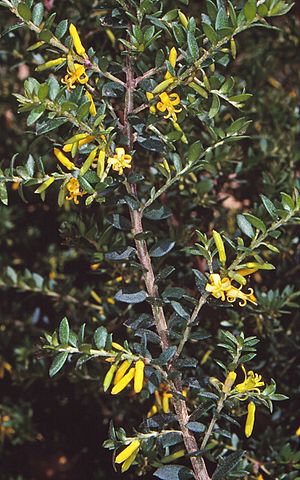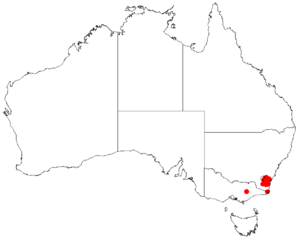Mountain geebung facts for kids
Quick facts for kids Mountain geebung |
|
|---|---|
 |
|
| Persoonia asperula in Wadbilliga National Park | |
| Scientific classification | |
| Genus: |
Persoonia
|
| Species: |
asperula
|
 |
|
| Occurrence data from Australasian Virtual Herbarium | |
| Synonyms | |
|
Persoonia nutans subsp. g sensu Jacobs & Pickard |
|
The Persoonia asperula, also known as the mountain geebung, is a special plant. It belongs to the plant family called Proteaceae. This plant is found only in south-eastern Australia, meaning it is endemic there.
It grows as a shrub, either standing tall or spreading low to the ground. It has smooth bark and yellow flowers. You can mostly find it in the Southern Highlands of New South Wales. There's also a small group of these plants in Victoria, but they might be a slightly different type.
Contents
What Does it Look Like?
The mountain geebung is a shrub that can stand upright or grow flat on the ground. Its bark is smooth, and its new shoots are often a bit hairy.
Leaves and Flowers
The leaves are usually oval or oblong, and sometimes shaped like an egg. They are about 7 to 22 millimeters (0.3 to 0.9 inches) long. They are also 2 to 6 millimeters (0.08 to 0.2 inches) wide. The edges of the leaves often curve backwards.
The bright yellow flowers grow either alone or in small groups of up to nine. They appear at the ends of the branches or where leaves meet the stem. Each flower sits on a short, hairy stalk, about 1 to 5 millimeters (0.04 to 0.2 inches) long.
The flower has four hairy parts called tepals, which are like petals. They are 9 to 11 millimeters (0.35 to 0.43 inches) long. These tepals are joined at the bottom, but their tips curl back. In the middle of the flower, there's a central part called a style. It's surrounded by four yellow parts called anthers, which hold pollen. These anthers are also joined at the bottom, with their tips curled back. If you look at the flower from the end, it looks like a cross!
Fruits
Mountain geebungs usually flower in January and February. After flowering, they grow fleshy green fruits with purple stripes. These fruits are called drupes, which are like small stone fruits.
How it Got its Name
This plant was officially named Persoonia asperula in 1991. Two scientists, Lawrie Johnson and Peter Weston, described it. They found a sample near the Back River and Wadbilliga National Park.
The name asperula comes from a Latin word meaning "somewhat rough." This name refers to the slightly rough feel of its leaves.
Where it Lives
The mountain geebung grows in special places in south-eastern New South Wales. It likes mountain heathlands and wet forests. You can find it in areas like the Tinderry Range and the Kybean Range.
There's also a small, separate group of these plants in Victoria, near the Moroka River. These Victorian plants have smaller leaves, only 3 to 8 millimeters (0.1 to 0.3 inches) long. Scientists think this group might be a different type of mountain geebung.
Sometimes, the mountain geebung grows near other similar plants. It can even mix with them to create new types of plants.
Protecting the Mountain Geebung
The mountain geebung is a special plant, and its numbers are getting low. In Victoria, it is listed as "threatened" under a law called the Flora and Fauna Guarantee Act 1988. It is also listed as "endangered" on a special list of rare or threatened plants in Victoria. This means efforts are being made to protect this unique Australian plant.

